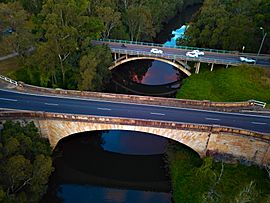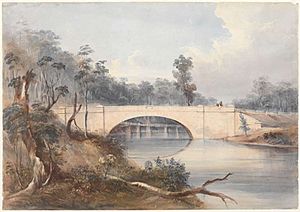Lansdowne Bridge facts for kids
The Lansdowne Bridge is a historic road bridge in southwestern Sydney, Australia. It carries the northbound lanes of the Hume Highway over Prospect Creek. The bridge connects the areas of Lansvale and Lansdowne.
This important bridge was named after Henry Petty-Fitzmaurice, 3rd Marquess of Lansdowne. He was an Irish politician who was friends with the Governor of New South Wales at the time, Sir Richard Bourke.
Today, the Lansdowne Bridge is owned by the state of New South Wales and looked after by Transport for NSW. It was added to the New South Wales State Heritage Register on June 20, 2000, because of its historical importance.
Quick facts for kids Lansdowne Bridge |
|
|---|---|

Lansdowne Bridge with its modern duplicate carrying the Hume Highway over Prospect Creek
|
|
| Coordinates | 33°53′25″S 150°58′02″E / 33.8902156386°S 150.9672223120°E |
| Carries | Hume Highway |
| Crosses | Prospect Creek, New South Wales |
| Other name(s) | Lennox Bridge |
| Named for | Henry Petty-Fitzmaurice, 3rd Marquess of Lansdowne |
| Characteristics | |
| Design | Arch bridge |
| Material | Sydney sandstone |
| Total length | 58 metres (190 ft) |
| Width | 9.1 metres (30 ft) |
| Longest span | 34 metres (110 ft) |
| Clearance above | 9.1 metres (30 ft) |
| History | |
| Designer | David Lennox |
| Construction begin | 1 January 1834 |
| Construction end | 1836 |
| Opened | 26 January 1836 |
| Official name | Lansdowne Bridge |
| Type | State heritage (built) |
| Criteria | undefined |
| Designated | 20 June 2000 |
| Reference no. | 01472 |
| Type | Road Bridge |
| Category | Transport – Land |
| Builders | David Lennox |
Contents
What Does the Bridge Look Like?
The Lansdowne Bridge is a large bridge made of sandstone. It has a single arch that stretches over Prospect Creek. The arch is supported by strong buttresses on each side.
The main part of the arch is about 33.5 meters (110 feet) wide. The bridge is about 23 meters (76 feet) above the water at its highest point. The sides of the bridge, called parapets, are simple and don't have many decorations. Some of the large stones that make up the arch are very big, up to 2.4 meters (8 feet) long!
Building the Lansdowne Bridge
The Lansdowne Bridge was designed and built between 1834 and 1836 by a talented stonemason named David Lennox.
Who Was David Lennox?
David Lennox was born in Scotland in 1788. He learned how to work with stone and became a skilled stonemason. Before coming to Australia, he worked on famous bridges like the Menai Suspension Bridge in Wales. He also worked on the Gloucester Bridge in the United Kingdom. These experiences taught him a lot about building strong bridges.
In 1832, Lennox moved to Australia and quickly found work with the government. He met the Surveyor-General, Thomas Mitchell, who was very impressed with Lennox's skills. Mitchell told the Governor of NSW, Sir Richard Bourke, about Lennox.
Governor Bourke then hired Lennox as a Sub-Inspector of Bridges. Later, in 1833, he became the Superintendent of Bridges.
Starting the Project
In 1832, Thomas Mitchell asked Lennox to build a new bridge over Prospect Creek. This new bridge would replace an older one called "Bowler's Bridge."
The stone used for the bridge was Hawkesbury sandstone. It came from a quarry about 11 kilometers (7 miles) away, on the bank of George's River. Workers used a special boat called a punt to transport the heavy stones to the construction site.
The bridge was built entirely by people who were forced to work, known as convicts. Lennox had asked for skilled workers, but he had to make do with the available labor.
Laying the Foundation Stone
On January 1, 1834, Governor Bourke visited the site to lay the first stone of the bridge. This was a special ceremony. However, just hours after it was placed, the inscription plate on the stone was stolen! Luckily, the original plate was found and put back on the bridge.
Building the Arch
By June 1834, the bridge was ready for a very important step: building the arch. This involved creating a strong wooden frame called "centring." This frame held each stone in place until the arch was complete and could support itself. It was a tricky process, as any mistakes could make the arch unstable or even cause it to collapse.
Opening the Bridge
The bridge was finished in late 1835. Governor Bourke decided to open it officially on January 26, 1836. This date was special because it was the 48th anniversary of the colony's founding. About 1,000 people came to watch the opening ceremony.
However, the bridge wasn't open for traffic right away. It took a few more months for the toll house to be completed. Once tolls started to be collected, the bridge quickly earned back the money it cost to build. Governor Bourke later said that the bridge only cost about £1,000 to build. He thought a similar bridge in England would have cost £7,000!
Why the Bridge is Important
The Lansdowne Bridge is considered one of the best examples of early Australian architecture. It's also seen as David Lennox's greatest work.
In 1956, another bridge was built next to the Lansdowne Bridge. This new bridge, completed in 1958, carries southbound traffic on the Hume Highway. It was designed as a concrete arch, similar to the original, which shows how much the original bridge was valued. Both bridges are still used today.
The Lansdowne Bridge has been recognized for its importance many times:
- In 1973, it was called "one of the finest examples of Colonial Architecture in Australia."
- In 1990, it was confirmed to have the largest span of any stone bridge in Australia.
- It's listed on the Register of the National Estate and the National Historic Engineering Landmark list. These lists recognize important historical and engineering achievements.
The bridge's listing on the New South Wales State Heritage Register highlights its importance in showing the history of New South Wales. It also recognizes its amazing design and technical achievement. The register notes that its size, look, and durability make it an outstanding example of early Australian engineering.
See also
- Boothtown Aqueduct
- List of bridges in Sydney
- Lennox Bridge, Glenbrook
- Lennox Bridge, Parramatta


